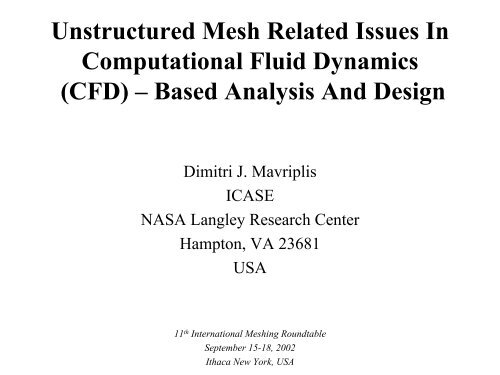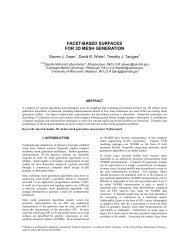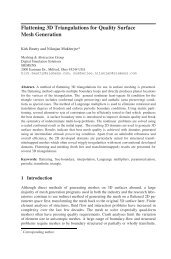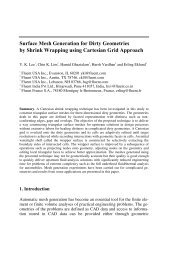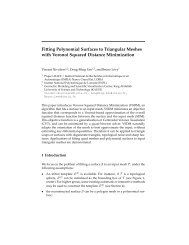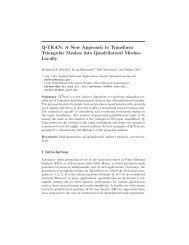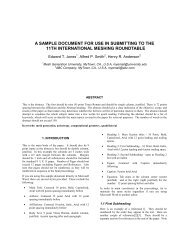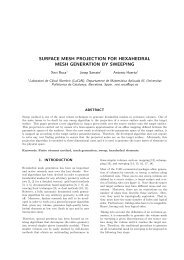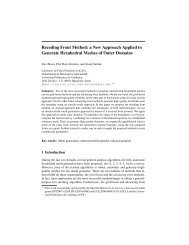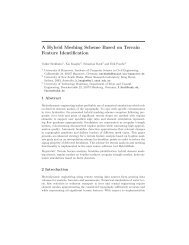Unstructured Mesh Related Issues In Computational Fluid Dynamics ...
Unstructured Mesh Related Issues In Computational Fluid Dynamics ...
Unstructured Mesh Related Issues In Computational Fluid Dynamics ...
You also want an ePaper? Increase the reach of your titles
YUMPU automatically turns print PDFs into web optimized ePapers that Google loves.
<strong>Unstructured</strong> <strong>Mesh</strong> <strong>Related</strong> <strong>Issues</strong> <strong>In</strong><strong>Computational</strong> <strong>Fluid</strong> <strong>Dynamics</strong>(CFD) – Based Analysis And DesignDimitri J. MavriplisICASENASA Langley Research CenterHampton, VA 23681USA11 th <strong>In</strong>ternational <strong>Mesh</strong>ing RoundtableSeptember 15-18, 2002Ithaca New York, USA
Overview• History and current state of unstructured gridtechnology of CFD– <strong>In</strong>fluence of grid generation technology– <strong>In</strong>fluence of solver technology• Examples of unstructured mesh CFD capabilities• Areas of current research– Adaptive mesh refinement– Moving meshes– Overlapping meshes– Requirements for design methods– Implications for higher-order accurate Discretizations
CFD Perspective on <strong>Mesh</strong>ingTechnology• CFD initiated in structured grid context– Transfinite interpolation– Elliptic grid generation– Hyperbolic grid generation• Smooth, orthogonal structured grids• Relatively simple geometries11th <strong>In</strong>ternational <strong>Mesh</strong>ing RoundtableSeptember 15-18,2002 Ithaca New York, USA
CFD Perspective on <strong>Mesh</strong>ing Technology• Evolved to Sophisticated Multiblock and OverlappingStructured Grid Techniques for Complex GeometriesOverlapping grid system on space shuttle (Slotnick, Kandula and Buning 1994)
CFD Perspective on <strong>Mesh</strong>ingTechnology• <strong>Unstructured</strong> meshes initially confined to FEcommunity– CFD Discretizations based on directional splitting– Line relaxation (ADI) solvers– Structured Multigrid solvers• Sparse matrix methods not competitive– Memory limitations– Non-linear nature of problems11th <strong>In</strong>ternational <strong>Mesh</strong>ing RoundtableSeptember 15-18,2002 Ithaca New York, USA
Current State of <strong>Unstructured</strong> <strong>Mesh</strong> CFDTechnology• Method of choice for many commercial CFDvendors– Fluent, StarCD, CFD++, …• Advantages– Complex geometries – Adaptivity– Parallelizability• Enabling factors– Maturing grid generation technology– Better Discretizations and solvers11th <strong>In</strong>ternational <strong>Mesh</strong>ing RoundtableSeptember 15-18,2002 Ithaca New York, USA
Maturing <strong>Unstructured</strong> GridGeneration Technology (1990-2000)• Anisotropic unstructured grid generation– External aerodynamics• Boundary layers, wakes: O(10**4)– Mapped Delaunay triangulations– Min-max triangulations– Hybrid methods • Advancing layers• Mixed prismatic – tetrahedral meshes11th <strong>In</strong>ternational <strong>Mesh</strong>ing RoundtableSeptember 15-18,2002 Ithaca New York, USA
Anisotropic <strong>Unstructured</strong> GridGeneration• Hybrid methods– Semi-structured nature– Less mature: issues• Concave regions• Neighboring boundaries• Conflicting resolution• Conflicting Stretchings11th <strong>In</strong>ternational <strong>Mesh</strong>ing RoundtableSeptember 15-18,2002 Ithaca New York, USAVGRIDns Advancing Layersc/o S. Pirzadeh, NASA Langley
Enabling CFD Solver Developments(1990 – 2000)• Edge-based data structure– Building block for all element types– Reduces memory requirements– Minimizes indirect addressing / gather-scatter– Graph of grid = Discretization stencil• Implications for solvers, Partitioners11th <strong>In</strong>ternational <strong>Mesh</strong>ing RoundtableSeptember 15-18,2002 Ithaca New York, USA
Enabling CFD Solver Developments• Multigrid solvers(1990 –2000)– Multigrid techniques enable optimal O(N) solutioncomplexity– Based on sequence of coarse and fine meshes– Originally developed for structured grids
Enabling CFD Solver Developments(1990 –2000)• Agglomeration Multigrid solvers for unstructured meshes– Coarse level meshes constructed by agglomerating fine gridcells/equations11th <strong>In</strong>ternational <strong>Mesh</strong>ing RoundtableSeptember 15-18,2002 Ithaca New York, USA
Agglomeration Multigrid•Automated Graph-Based Coarsening Algorithm•Coarse Levels are Graphs•Coarse Level Operator by Galerkin Projection•Grid independent convergence rates (order of magnitude improvement)
Enabling CFD Solver Developments• Line solvers for Anisotropic problems– Lines constructed in mesh using weighted graph algorithm– Strong connections assigned large graph weight– (Block) Tridiagonal line solver similar to structured grids
Enabling CFD Solver Developments(1990 –2000)• Graph-based Partitioners for parallel load balancing– Metis, Chaco, Jostle• Edge-data structure graph of grid• Agglomeration Multigrid levels = graphs• Excellent load balancing up to 1000’s of processors– Homogeneous data-structures– (Versus multi-block / overlapping structured grids)11th <strong>In</strong>ternational <strong>Mesh</strong>ing RoundtableSeptember 15-18,2002 Ithaca New York, USA
Practical Examples• VGRIDns tetrahedral grid generator• NSU3D Multigrid flow solver– Large scale massively parallel case– Fast turnaround medium size problem11th <strong>In</strong>ternational <strong>Mesh</strong>ing RoundtableSeptember 15-18,2002 Ithaca New York, USA
NASA Langley Energy Efficient Transport• Complex geometry– Wing-body, slat, double slotted flaps, cutouts• Experimental data from Langley 14x22ft wind tunnel– Mach = 0.2, Reynolds=1.6 million– Range of incidences: -4 to 24 degrees11th <strong>In</strong>ternational <strong>Mesh</strong>ing RoundtableSeptember 15-18,2002 Ithaca New York, USA
<strong>In</strong>itial <strong>Mesh</strong> Generation (VGRIDns)S. Pirzadeh, NASA Langley• Combined advancing layers- advancing front– Advancing layers: thin elements at walls– Advancing front: isotropic elements elsewhere• Automatic switching from AL to AF based on:– Cell aspect ratio– Proximity of boundaries of other fronts– Variable height for advancing layers• Background Cartesian grid for smooth spacing control• Spanwise stretching– Factor of 3 reduction in grid size11th <strong>In</strong>ternational <strong>Mesh</strong>ing RoundtableSeptember 15-18,2002 Ithaca New York, USA
VGRID Tetrahedral <strong>Mesh</strong>• 3.1 million vertices, 18.2 million tets, 115,489 surface pts• Normal spacing: 1.35E-06 chords, growth factor=1.3
Prism Merging Operation• Combine Tetrahedra triplets in advancing-layersregion into prisms– Prisms entail lower complexity for solver• VGRIDns identifies originating boundary pointfor ALR vertices– Used to identify candidate elements– Pyramids required as transitional elements
Prism Merging Operation• <strong>In</strong>itial mesh: 18.2M Tetrahedra• Merged mesh: 3.9M prisms, 6.6M Tets, 47Kpyramids– 64% of Tetrahedra merged11th <strong>In</strong>ternational <strong>Mesh</strong>ing RoundtableSeptember 15-18,2002 Ithaca New York, USA
Global <strong>Mesh</strong> Refinement• High-resolution meshes require large parallelmachines• Parallel mesh generation difficult– Complicated logic– Access to commercial preprocessing, CAD tools• Current approach– Generate coarse (O(10**6) vertices on workstation– Refine on supercomputer11th <strong>In</strong>ternational <strong>Mesh</strong>ing RoundtableSeptember 15-18,2002 Ithaca New York, USA
Global <strong>Mesh</strong> Refinement• Refinement achieved by element subdivision• Global refinement: 8:1 increase in resolution• <strong>In</strong>-Situ approach obviates large file transfers• <strong>In</strong>itial mesh: 3.1 million vertices– 3.9M prisms, 6.6M Tets, 47K pyramids• Refined mesh: 24.7 million vertices– 31M prisms, 53M Tets, 281K pyramids– Refinement operation: 10 Gbytes, 30 minutessequentially11th <strong>In</strong>ternational <strong>Mesh</strong>ing RoundtableSeptember 15-18,2002 Ithaca New York, USA
NSU3D <strong>Unstructured</strong> <strong>Mesh</strong>Navier-Stokes Solver• Mixed element grids– Tetrahedra, prisms, pyramids, hexahedra• Edge data-structure• Line solver in BL regions near walls• Agglomeration Multigrid acceleration• Newton Krylov (GMRES) acceleration option• Spalart-Allmaras 1 equation turbulence model11th <strong>In</strong>ternational <strong>Mesh</strong>ing RoundtableSeptember 15-18,2002 Ithaca New York, USA
Parallel Implementation• Domain decomposition with OpenMP/MPIcommunication– OpenMP on shared memory architectures– MPI on distributed memory architectures– Hybrid capability for clusters of SMPs• Weighted graph partitioning (Metis) (Chaco)• Coarse and fine MG levels partitionedindependently11th <strong>In</strong>ternational <strong>Mesh</strong>ing RoundtableSeptember 15-18,2002 Ithaca New York, USA
Computed Pressure Contours on Coarse Grid• Mach=0.2, <strong>In</strong>cidence=10 degrees, Re=1.6M
Computed Versus Experimental Results• Good drag prediction• Discrepancies near stall
Multigrid Convergence History• <strong>Mesh</strong> independent property of Multigrid• GMRES effective but requires extra memory
Parallel Scalability• Good overall Multigrid scalability– <strong>In</strong>creased communication due to coarse grid levels– Single grid solution impractical (>100 times slower)• 1 hour soution time on 1450 PEs
AIAA Drag Prediction Workshop (2001)• Transonic wing-body configuration• Typical cases required for design study– Matrix of mach and CL values– Grid resolution study• Follow on with engine effects (2003)
Cases Run• Baseline grid: 1.6 million points– Full drag polars forMach=0.5,0.6,0.7,0.75,0.76,0.77,0.78,0.8– Total = 72 cases• Medium grid: 3 million points– Full drag polar for each mach number– Total = 48 cases• Fine grid: 13 million points– Drag polar at mach=0.75– Total = 7 cases11th <strong>In</strong>ternational <strong>Mesh</strong>ing RoundtableSeptember 15-18,2002 Ithaca New York, USA
Sample Solution (1.65M Pts)• Mach=0.75, CL=0.6, Re=3M• 2.5 hours on 16 Pentium IV 1.7GHz
Drag Polar at Mach = 0.75• Grid resolution study• Good comparison with experimental data
Cases Run on ICASE Cluster• 120 Cases (excluding finest grid)• About 1 week to compute all cases11th <strong>In</strong>ternational <strong>Mesh</strong>ing RoundtableSeptember 15-18,2002 Ithaca New York, USA
Current and Future <strong>Issues</strong>• Adaptive mesh refinement• Moving geometry and mesh motion• Moving geometry and overlapping meshes• Requirements for gradient-based design• Implications for higher-orderDiscretizations11th <strong>In</strong>ternational <strong>Mesh</strong>ing RoundtableSeptember 15-18,2002 Ithaca New York, USA
Adaptive <strong>Mesh</strong>ing• Potential for large savings through optimizedmesh resolution– Well suited for problems with large range of scales– Possibility of error estimation / control– Requires tight CAD coupling (surface pts)• Mechanics of mesh adaptation• Refinement criteria and error estimation11th <strong>In</strong>ternational <strong>Mesh</strong>ing RoundtableSeptember 15-18,2002 Ithaca New York, USA
Mechanics of Adaptive <strong>Mesh</strong>ing• Various well know isotropic mesh methods– <strong>Mesh</strong> movement• Spring analogy• Linear elasticity– Local Remeshing– Delaunay point insertion/Retriangulation– Edge-face swapping– Element subdivision• Mixed elements (non-simplicial)• Anisotropic subdivision required in transition regions11th <strong>In</strong>ternational <strong>Mesh</strong>ing RoundtableSeptember 15-18,2002 Ithaca New York, USA
Subdivision Types for Tetrahedra11th <strong>In</strong>ternational <strong>Mesh</strong>ing RoundtableSeptember 15-18,2002 Ithaca New York, USA
Subdivision Types for Prisms11th <strong>In</strong>ternational <strong>Mesh</strong>ing RoundtableSeptember 15-18,2002 Ithaca New York, USA
Subdivision Types for Pyramids11th <strong>In</strong>ternational <strong>Mesh</strong>ing RoundtableSeptember 15-18,2002 Ithaca New York, USA
Subdivision Types for Hexahedra11th <strong>In</strong>ternational <strong>Mesh</strong>ing RoundtableSeptember 15-18,2002 Ithaca New York, USA
Adaptive Tetrahedral <strong>Mesh</strong> by Subdivision11th <strong>In</strong>ternational <strong>Mesh</strong>ing RoundtableSeptember 15-18,2002 Ithaca New York, USA
Adaptive Hexahedral <strong>Mesh</strong> by Subdivision11th <strong>In</strong>ternational <strong>Mesh</strong>ing RoundtableSeptember 15-18,2002 Ithaca New York, USA
Adaptive Hybrid <strong>Mesh</strong> by Subdivision11th <strong>In</strong>ternational <strong>Mesh</strong>ing RoundtableSeptember 15-18,2002 Ithaca New York, USA
Anisotropic Adaptation Methods• Large potential savings for 1 or 2D features– Directional subdivision• Assumes element faces to line up with flow features• Combine with mesh motion– Mapping techniques• Hessian based• Grid quality11th <strong>In</strong>ternational <strong>Mesh</strong>ing RoundtableSeptember 15-18,2002 Ithaca New York, USA
Refinement Criteria• Weakest link of adaptive meshing methods– Obvious for strong features– Difficult for non-local (ie. Convective) features• eg. Wakes– Analysis assumes in asymptotic error convergence region• Gradient based criteria• Empirical criteria• Effect of variable discretization error in designstudies, parameter sweeps11th <strong>In</strong>ternational <strong>Mesh</strong>ing RoundtableSeptember 15-18,2002 Ithaca New York, USA
Adjoint-based Error Prediction• Compute sensitivity of global cost function to localspatial grid resolution• Key on important output, ignore other features– Error in engineering output, not discretization error• e.g. Lift, drag, or sonic boom …• Captures non-local behavior of error– Global effect of local resolution• Requires solution of adjoint equations– Adjoint techniques used for design optimization11th <strong>In</strong>ternational <strong>Mesh</strong>ing RoundtableSeptember 15-18,2002 Ithaca New York, USA
Adjoint-based <strong>Mesh</strong> Adaptation CriteriaReproduced from Venditti and Darmofal (MIT, 2002)
Adjoint-based <strong>Mesh</strong> Adaptation CriteriaReproduced from Venditti and Darmofal (MIT, 2002)
Adjoint-based <strong>Mesh</strong> Adaptation CriteriaReproduced from Venditti and Darmofal (MIT, 2002)
Overlapping <strong>Unstructured</strong> <strong>Mesh</strong>es• Alternative to moving mesh for large scale relativegeometry motion• Multiple overlapping meshes treated as singledata-structure– Dynamic determination of active/inactive/ghost cells• Advantages for parallel computing– Obviates dynamic load rebalancing required with meshmotion techniques– <strong>In</strong>tergrid communication must be dynamicallyrecomputed and rebalanced• Concept of Rendez-vous grid (Plimpton and Hendrickson)11th <strong>In</strong>ternational <strong>Mesh</strong>ing RoundtableSeptember 15-18,2002 Ithaca New York, USA
Overlapping <strong>Unstructured</strong> <strong>Mesh</strong>es• Simple 2D transient example11th <strong>In</strong>ternational <strong>Mesh</strong>ing RoundtableSeptember 15-18,2002 Ithaca New York, USA
Gradient-based Design Optimization• Minimize Cost Function F with respect to designvariables v, subject to constraint R(w) = 0–F= drag, weight, cost–v= shape parameters–w= Flow variables– R(w) = 0 Governing Flow Equations• Gradient Based Methods approach minimumalong direction : ∂F−∂v11th <strong>In</strong>ternational <strong>Mesh</strong>ing RoundtableSeptember 15-18,2002 Ithaca New York, USA
Grid <strong>Related</strong> <strong>Issues</strong> for Gradient-basedDesign• Parametrization of CAD surfaces• Consistency across disciplines– eg. CFD, structures,…• Surface grid motion• <strong>In</strong>terior grid motion• Grid sensitivities• Automation / Parallelization11th <strong>In</strong>ternational <strong>Mesh</strong>ing RoundtableSeptember 15-18,2002 Ithaca New York, USA
Preliminary Design GeometryX34 CAD Modelc/o J. Samareh, NASA Langley23,555 curves and surfaces
Launch Vehicle Shape Parameterizationc/o J. Samareh, NASA Langley
Sensitivity Analysisobjective function(e.g., Stress, C D)v design variables(e.g., span, camber)∂F∂v∂F ∂Gridf ∂Grids∂Geometry= x x x∂Grid f∂Grids∂Geometry∂v geometry modeler (CAD)analysis codefield grid generatorsurface grid generator• Manual differentiation• Automatic differentiation tools (e.g., ADIFOR and ADIC)• Complex variables• Finite-difference approximationsc/o J. Samareh, NASA Langley
Finite-Difference Approximation Errorfor Sensitivity DerivativesParameterizedHSCT Modelc/o J. Samareh, NASA Langley
Grid Sensitivities∂Grid∂vf=∂Grid∂Gridfsx∂Gridsx∂Geometry∂Geometry∂v• Ideally should be available from grid/cad software– Analytical formulation most desirable– Burden on grid / CAD software– Discontinous operations present extra challenges• Face-edge swapping• Point addition / removal• <strong>Mesh</strong> regeneration11th <strong>In</strong>ternational <strong>Mesh</strong>ing RoundtableSeptember 15-18,2002 Ithaca New York, USA
High-Order Accurate Discretizations• Uniform X2 refinement of 3D mesh:– Work increase = factor of 8–2 nd order accurate method: accuracy increase = 4–4 th order accurate method: accuracy increase = 16• For smooth solutions• Potential for large efficiency gains– Spectral element methods– Discontinuous Galerkin (DG)– Streamwise Upwind Petrov Galerkin (SUPG)
Higher-Order Accurate Discretizations• Transfers burden from grid generation to Discretization11th <strong>In</strong>ternational <strong>Mesh</strong>ing RoundtableSeptember 15-18,2002 Ithaca New York, USA
Spectral Element Solution of Maxwell’s EquationsJ. Hesthaven and T. Warburton (Brown University)
High-Order Discretizations• Require more complete surface definition• Curved surface elements– Additional element points– Surface definition (for high p)
Combined H-P Refinement• Adaptive meshing (h-ref) yields constant factorimprovement– After error equidistribution, no further benefit• Order refinement (p-ref) yields asymptotic improvement– Only for smooth functions– <strong>In</strong>effective for inadequate h-resolution of feature– Cannot treat shocks• H-P refinement optimal (exponential convergence)– Requires accurate CAD surface representation11th <strong>In</strong>ternational <strong>Mesh</strong>ing RoundtableSeptember 15-18,2002 Ithaca New York, USA
Conclusions• <strong>Unstructured</strong> mesh CFD has come of age– Combined advances in grid and solver technology– <strong>In</strong>viscid flow analysis (isotropic grids) mature– Viscous flow analysis competitive• Complex geometry handling facilitated• Adaptive meshing potential not fully exploited• Additional considerations in future– Design methodologies– New discretizations– New solution techniques– H-P Refinement11th <strong>In</strong>ternational <strong>Mesh</strong>ing RoundtableSeptember 15-18,2002 Ithaca New York, USA


